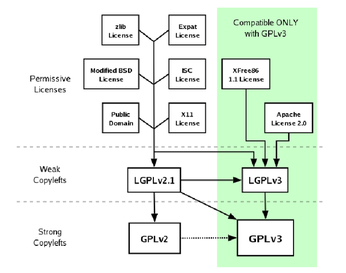FSF Publishes New Quick Guide on GPLv3
The quick guide gives a short and understandable explanation of the objectives of version 3 of the GPL; recent discussions on GPLv3 had caused many developers to forget the generic purpose of the license – guaranteeing the freedom of software development.
The document briefly recapitulates what the General Public License (GPL) aims to achieve. The author goes on to explain the changes between versions 2 and 3 of the GPL, and the motivations behind the changes citing three threats to freedom. One of them is tivoization, named after the Tivo digital video recorder that contains GPL’d software but prevents users from modifying the GPL programs by validating a digital signature. The other two threats that led to changes in the GPL are Digital Rights Management and Microsoft’s patent covenenant. The author also refers to interfaces to other licenses. The author of the Quick Guide, Brett Smith from the Free Software Foundation (FSF), has posted the guide on the FSF announce mailing list.
The changes introduced by GPLv3 include new compatibilities to other licenses, as shown by the graphic from the Quick Guide.
The Open Source community can view the text as an impetus to understand the GPL as an opportunity rather than a bone of contention or a threat. Brett’s short, informal announcement closes with the words: "We hope this serves as a useful resource for developers considering adopting GPLv3 for their own projects." Shortly afterwards a senior Red Hat developer commented: "Excellent job, Brett."
The guide is available online, or as a PDF document, and as a zipped tarball in text only format. According to GNU's Who Brett Smith has been with the Free Software Foundation since 2002, and has worked as the Chief Webmaster and Shipping Manager, before becoming the "licensing guru" at the FSF’s licensing and compliance lab which provides “the public with a "knowledge infrastructure" surrounding the GNU GPL and free software licensing, and enforcing the license on FSF-copyrighted software.”
Subscribe to our Linux Newsletters
Find Linux and Open Source Jobs
Subscribe to our ADMIN Newsletters
Support Our Work
Linux Magazine content is made possible with support from readers like you. Please consider contributing when you’ve found an article to be beneficial.

News
-
Parrot OS Switches to KDE Plasma Desktop
Yet another distro is making the move to the KDE Plasma desktop.
-
TUXEDO Announces Gemini 17
TUXEDO Computers has released the fourth generation of its Gemini laptop with plenty of updates.
-
Two New Distros Adopt Enlightenment
MX Moksha and AV Linux 25 join ranks with Bodhi Linux and embrace the Enlightenment desktop.
-
Solus Linux 4.8 Removes Python 2
Solus Linux 4.8 has been released with the latest Linux kernel, updated desktops, and a key removal.
-
Zorin OS 18 Hits over a Million Downloads
If you doubt Linux isn't gaining popularity, you only have to look at Zorin OS's download numbers.
-
TUXEDO Computers Scraps Snapdragon X1E-Based Laptop
Due to issues with a Snapdragon CPU, TUXEDO Computers has cancelled its plans to release a laptop based on this elite hardware.
-
Debian Unleashes Debian Libre Live
Debian Libre Live keeps your machine free of proprietary software.
-
Valve Announces Pending Release of Steam Machine
Shout it to the heavens: Steam Machine, powered by Linux, is set to arrive in 2026.
-
Happy Birthday, ADMIN Magazine!
ADMIN is celebrating its 15th anniversary with issue #90.
-
Another Linux Malware Discovered
Russian hackers use Hyper-V to hide malware within Linux virtual machines.

